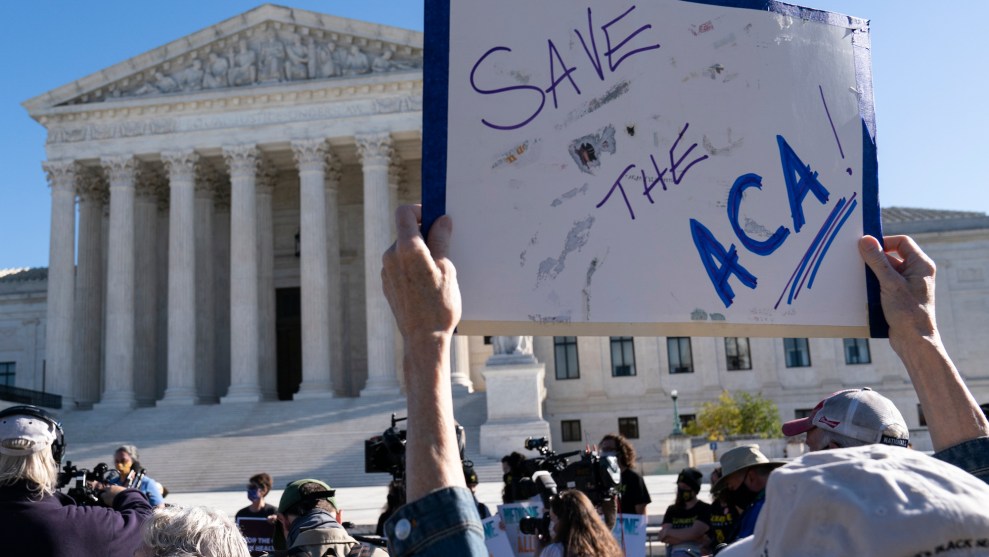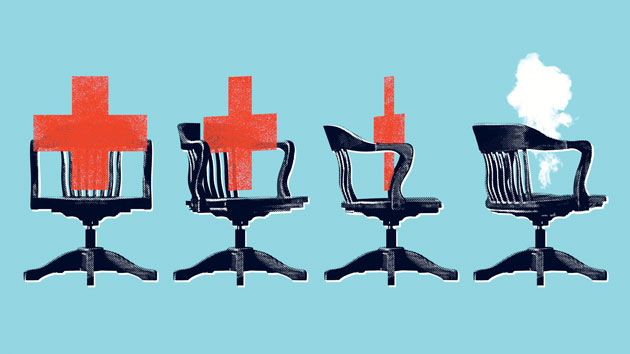
A demonstrator holds a sign in front of the U.S. Supreme Court as arguments are heard about the Affordable Care Act, Tuesday, Nov. 10, 2020, in Washington. Alex Brandon/AP Photo
John Nantz doesn’t like his health insurance plan. At $266 a month, he thinks the bronze plan he buys off the federal health exchange is too expensive, plus the $6,500 deductible is too high. The single, childless, 34-year-old management consultant in Austin says he doesn’t need much health care anyway, just the sports therapists and chiropractors he pays for out of pocket or through a health savings account.
Hating your health insurance plan is a time-honored American tradition. Many of those lucky enough to have insurance still chafe under high premiums and deductibles and narrow networks of provider options. But Nantz has taken more drastic action to do something about it than, say, grousing to colleagues or going uninsured. He has joined 18 red states as a plaintiff in a lawsuit challenging the Affordable Care Act that last week reached the Supreme Court for oral arguments. He has asked the high court to overturn the entire law so he can get what he thinks will be better insurance in the “competitive” free market.
Unfortunately for Nantz, if oral arguments in the case were any indication, being unhappy with your health insurance plan may not be enough to persuade the Supreme Court that you’ve got a case for blowing up the ACA and causing 20 million of your fellow citizens to lose their coverage.
California v. Texas is the latest challenge to Obamacare that has reached the Supreme Court since the law was enacted in 2010. This particular case was filed after Congress essentially eliminated the law’s individual mandate, the provision requiring people to purchase health insurance or pay a fine to the IRS. Congress didn’t repeal the provision. Instead, as part of the 2017 Trump tax cut bill, it simply reduced the fine for being uninsured to zero. In response, opponents of the bill, led by the state of Texas, went to court to attack the law once more, arguing that without the fine to enforce the individual mandate, the rest of the law should be ruled unconstitutional.
Their case was weak from the outset, as the states first had to prove that they were harmed by the elimination of the individual mandate—a tough order given that it only applies to individuals. The states argued, somewhat improbably, that when Congress abolished the fine for being uninsured, it somehow caused more people to enroll in state-funded health programs like Medicaid and the Children’s Health Insurance Program, which cost the state money and thus gave them standing to sue. Lawyers for the states were unable to find a single person who would testify to the fact that they actually had done this, so they also argued that the states had also incurred various paperwork burdens. That argument may have been enough to get them through the courthouse door, but it wasn’t one that would hold up to much scrutiny.
That’s where John Nantz comes in. The Texas Public Policy Foundation, a conservative think tank, recruited him and another self-employed man, Neill Hurley, to join the case as plaintiffs to hedge against the possibility that a federal judge would toss the states’ case for lack of any recognizable harm from the law they were challenging. Nantz and Hurley are just the latest in a string of plaintiffs in federal challenges to the ACA who have had extremely dubious claims of having been harmed by a law designed to give them better and cheaper health insurance.
Since the law was passed as one of Obama’s signature achievements, it’s become a lightning rod for conservative rage at government overreach, while it has continued to remain popular with the greater public. More than 70 times, Republicans have tried to repeal the law and failed, even when they controlled both houses of Congress and the White House. As a result, opponents of the law have turned to the courts to try to achieve what they haven’t been able to do through legislation. But the popularity of the law has also hampered their ability to find sympathetic and qualified people to headline their lawsuits, and fewer still who were willing to sabotage a law that’s extended health insurance to 20 million people. Those they have already deployed haven’t inspired confidence in the righteousness of their cause.
For example, back in 2014, West Virginia small-businessman David Klemencic was a plaintiff in Halbig v. Burwell. He sued the Department of Health and Human Services over the ACA because the law forced him to either pay a fine of at least $100 for being uninsured or buy a bronze insurance plan off the federal health exchange that, with a generous subsidy, would have cost him a mere $21 a year. And there was a Virginia woman, Brenda Levy, then 64, with a host of health problems who’d been paying $1,500 a month for health insurance and was recruited by a conservative think tank to be a plaintiff in the 2015 Supreme Court case King v. Burwell. How did Obamacare hurt her? Court documents showed that thanks to the ACA, she could get a bronze plan off the exchange for $148 a month. That apparently did nothing to assuage her opposition to Obamacare, which, she insisted in an interview with me, was that it gave the government too much control over Americans’ medical treatment.
During oral arguments in the King case before the 4th Circuit Court of Appeals, Judge Andre Davis repeatedly expressed skepticism about the plaintiffs and their alleged injuries. He quizzed the lead lawyer on the case, Michael Carvin, a partner at the law firm Jones Day, on why he hadn’t brought the suit as a class action—the traditional vehicle for public interest litigation that usually covers many potential plaintiffs. Davis suggested that the reason was that “nobody wants what you’re after here!” Nonetheless, that case made its way to the Supreme Court in 2015, where the late Justice Ruth Bader Ginsburg also grilled Carvin about the plaintiffs’ alleged injuries from the ACA.
A plaintiff, she declared, “has to have a concrete stake in the question…you would have to prove the standing if this gets beyond the opening door.” Indeed, Brenda Levy would qualify for Medicare before the court even decided the case, making her concerns about the ACA moot. The court upheld the health care law but didn’t really address the question of whether the plaintiffs had standing to bring the case because it hadn’t been raised in the lower courts.
This time, though, in Californa v. Texas, standing is at the heart of the case, and the Supreme Court has been asked directly to rule on the question of whether Nantz, Hurley, and the states have suffered any harm that would entitle them to seek redress in federal court.
Nantz had been a member of the Texas Public Policy Institute’s young professional group in Austin. After graduating from Stanford, he went to work for McKinsey & Company and in 2014 started his own consulting firm, Redwood Advisors, where, according to court filings, he advises clients “on maximizing growth potential.” Some of those clients are health care companies—including at least one that is opposing him in the ACA case. According to the company’s website, Redwood Advisors has done work for Blue Cross Blue Shield. The health insurance giant has filed an amicus brief in the case supporting the ACA and excoriating Nantz and his fellow plaintiffs for “ask[ing] this court to wreak havoc on the healthcare system in the United States.”
Nantz’s personal experience with what health insurance was like before the Affordable Care Act is limited: He was still in college when the bill passed. Nonetheless, opponents of the ACA hoped that individual plaintiffs like him might fare better in court than the states challenging the law. Both he as an individual and states like Texas must attempt to prove that the law has inflicted harm on them. That’s not so easy now that there’s no longer any fine for going uninsured; Nantz can simply opt out of insurance if he wants to, penalty free.
But according to his statements in the case, Nantz doesn’t want to do that—not because he’s worried that he needs insurance lest he get hit by a bus, catch COVID-19, or get caught in the crossfire of a mass shooting. Instead, he says he buys insurance because he believes that “following the law is the right thing to do.” (Nantz’s lawyer, Robert Henneke, did not respond to an inquiry from Mother Jones.) In 2018, Tom Miller, a resident health policy fellow at the American Enterprise Institute told Politico that Nantz and Hurley were like people who don’t “take a tag off of their mattress” because of the legal warning, even though there’s no possible chance the government will go after them for it.
Nantz is not wrong that his bronze plan could be more expensive than it might have been before the ACA passed in 2010. He makes too much money to receive a federal subsidy, and the individual insurance market is still a hot mess, in part because the risk pool is so small. High costs have driven healthy young people out of the individual market, leaving only older and sicker Americans seeking coverage. But the number of people, like Nantz, who don’t get insurance from an employer or a government program like Medicare or Medicaid and who buy coverage through the exchange but are also too rich to qualify for a subsidy is pretty small—about 3.4 million in 2019.
By comparison, more than 15 million people gained insurance through the ACA’s Medicaid expansion. Nantz’s bronze plan is likely to be much more comprehensive than what was available at that price before the law passed thanks to the ACA’s requirements for basic minimum coverage. And then again, no one is forcing him to buy it. Even if he succeeds in persuading the Supreme Court to overturn the ACA, Nantz’s insurance problems aren’t likely to improve. Experts predict that individual insurance might get even more expensive as healthy young people drop coverage and the markets skew towards sicker and older customers.
Despite the weakness of the plaintiff’s claims of injury, the 5th Circuit Court of Appeals ruled in their favor in December 2019. The court found that the plaintiffs did have standing to sue, and it upheld a lower court ruling that the individual mandate is now unconstitutional, even if the penalty it carries is zero. In a scathing dissent, 5th Circuit Judge Carolyn Dineen King focused on the plaintiffs’ lack of standing and their thin claims to having suffered the sort of harm or threat of government action that would qualify them to sue in federal court. She described Nantz’s alleged injury in the case as “entirely self-inflicted,” and noted that federal law doesn’t allow someone to challenge a statute based on a self-inflicted injury. Further, King wrote, the law that ended the individual mandate “does nothing more than require individuals to pay zero dollars to the IRS if they do not purchase health insurance, which is to say it does nothing at all…Nobody has standing to challenge a law that does nothing.”
If the Supreme Court rules on the standing question in favor of Nantz, the implications extend far beyond the Affordable Care Act. By doing so, it could widely expand the range of people who could claim the right to sue in federal court without proving any concrete injury—a possibility that puts the court’s conservatives in an especially tricky bind. Over the past half-century, conservative justices have sharply limited access to the courts in environmental and civil rights cases by curtailing the rules for standing. In 2013, a conservative majority tossed out a lawsuit filed by Amnesty International, media, labor and other human rights organizations challenging the federal government’s warrantless wiretapping program, ruling that they had no standing to sue. “The law of Article III standing, which is built on separation-of-powers principles, serves to prevent the judicial process from being used to usurp the powers of the political branches,” wrote Justice Samuel Alito.
Chief Justice John Roberts reiterated that point during oral arguments in the ACA case Tuesday. “It’s an important doctrine,” he told Acting Solicitor General Jeffrey Wall, who represented the Trump administration. “The only reason we have the authority to interpret the Constitution is because we have the responsibility of deciding actual cases, and that’s what standing filters out.”
Allowing such weak plaintiffs to pursue the ACA case might also open the federal courts to a flood of exactly the sort of litigation they don’t want to hear—nuisance suits. As California Solicitor General Michael Mongan noted during oral arguments, such a reading of the law would allow a host of crazy challenges to the ACA to go forward. There are many provisions in the ACA that have nothing to do with health insurance, for instance, such as the requirement that chain restaurants post calorie counts on their menus. Anyone who doesn’t like them could bring suit in federal court to overturn the entire 900-page law, without having to prove that the provision actually harmed them. “Your theory of standing is that a person who’s not actually injured by part of the law can challenge that part of the law and, through that, try to strike down other parts of the law that do challenge him or that do injure him,” Roberts told Wall later. “I think that really expands standing dramatically.”
While Roberts’s position on standing seemed pretty clear during oral arguments, University of Michigan law professor Nicholas Bagley says it’s hard to know where the court will come down on the issue in the end. “The justices were all over the map on standing,” he says. “In general, conservatives have been more hawkish on standing than liberals, but the doctrine is malleable, and this case is unusual. That may scramble our normal assumptions.”
The Chief Justice is a well-known standing hawk, as is Justice Brett Kavanaugh. The court’s newest justice, Amy Coney Barrett, could also fall into that camp. While she has little record to reflect her views one way or another, she is a protégé of the late Justice Antonin Scalia, who authored the majority decision in the seminal 1992 case Lujan v. Defenders of Wildlife, which held that a group of environmentalists lacked standing to challenge environmental regulations and sharply limited Congress’s power to allow private citizens to bring cases in federal court. Scalia wrote that plaintiffs must have a concrete injury to bring suit in federal court, not a “conjectural or hypothetical one.”
On Tuesday, even Justice Clarence Thomas, who rarely speaks during oral arguments, chimed in to question how Nantz and Hurley were actually injured by the ACA. “The individual mandate now has no enforcement mechanism,” he told Kyle Hawkins, the Texas solicitor general, who argued the case for the law’s opponents. “So it’s really hard to determine exactly what the threat is of an action against you. Could you just give us an understanding of what your injury is?”












